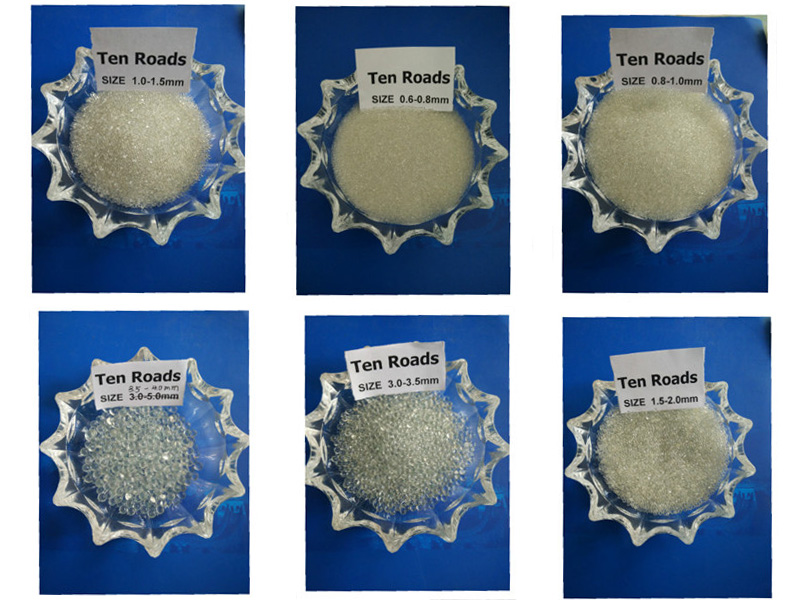Are glass beads safe for sandblasting?
Sandblasting, also known as grit blasting, is a common method used in industries such as construction, manufacturing, art and restoration. It involves the powerful propulsion of an abrasive, such as sand or glass beads, at high speeds to clean, strip or etch a surface. Of the various abrasives available, glass beads are often chosen for their versatility and are considered a safer alternative to traditional sand abrasives. However, it is vital to explore the safety of using glass beads in sandblasting to determine if they are indeed a safe choice for this application.

Understanding Glass Beads in Sandblasting
Glass beads used in sandblasting are typically made from recycled glass. These beads are spherical in shape and come in a variety of sizes for different applications, from fine, precision work to more aggressive cleaning and surface preparation. The spherical shape of the beads ensures that they strike the surface evenly, reducing the likelihood of causing pitting or damage to the substrate. They are commonly used for tasks such as cleaning moulds, removing paint or rust from metal and deburring. Glass beads are considered an effective and efficient abrasive material, but their safety depends on several factors.
Safety of glass beads in sandblasting
Environmental impact:
Glass beads are often used in sandblasting due to their environmental friendliness. Unlike traditional sand abrasives, glass beads are non-toxic, non-reactive and do not release harmful substances into the environment. This property makes them a safer choice from an environmental standpoint, as they do not contribute to air or water pollution.
Worker Safety:
The safety of sandblasting workers is the most important issue. Glass beads are generally considered safer for operators than other abrasive materials such as silica sand. Silica dust produced when sandblasting with materials such as silica sand can cause serious health problems, including silicosis (a lung disease). Glass beads, on the other hand, produce the least amount of dust and are less likely to cause respiratory hazards. However, it is important to note that adequate safety measures, such as protective equipment and proper ventilation, should still be taken when using glass beads for sandblasting.
Surface Safety:
The main issue with sandblasting is not only the safety of the workers but also the integrity of the surface being treated. In this regard, glass beads are considered a safer option as they are less likely to cause surface damage than more corrosive abrasives such as aluminium oxide or steel shot. The rounded shape and reduced abrasive nature of glass beads make them suitable for applications where a surface finish needs to be maintained.
Dust Collection and Control:
Although glass beads produce less dust than other abrasives, it is still critical to have an effective dust collection and control system when blasting with glass beads. Adequate ventilation and the use of properly designed blasting equipment are critical to controlling airborne particulates and ensuring the safety of workers and the surrounding environment.
Appropriate equipment and techniques:
The safety of sandblasting depends greatly on the proper use of equipment and techniques. Using the correct equipment, regulating air pressure, and employing the proper nozzle size are important aspects of safety when working with glass beads. Proper training is essential to ensure that operators understand the equipment and techniques required for safe and effective glass bead blasting.
Surface Preparation:
Obtaining safe and satisfactory blasting results also depends on the proper treatment of the surface being treated. Surface preparation includes cleaning, degreasing and masking areas that should not be sandblasted. Ensuring that the surface is free from contaminants is critical because it not only improves the quality of the surface preparation, but also increases safety by preventing unintended reactions or problems during the blasting process.
Conclusion
In the field of sandblasting, the safety of workers and surfaces is of paramount importance. Glass beads are often considered a safer option for sandblasting due to their environmental properties, reduced dust generation and gentle abrasive properties compared to some other abrasive materials. However, this does not mean that using glass beads is completely risk-free. Adequate safety measures, including worker protection, proper equipment and dust control, must be taken to ensure a safe and effective sandblasting operation.
When used correctly, glass beads can provide excellent results, whether they are used for cleaning, stripping or surface preparation. Their spherical shape and reduced abrasive nature make them an attractive choice for applications where surface protection is a concern. That said, operators must be well trained, equipped with the necessary safety gear, and aware of the specific requirements of each sandblasting project. By following best practices and adhering to safety guidelines, glass beads can be a safe and effective abrasive choice in sandblasting, contributing to success and minimising potential risks.
561
0
0


Comments
All Comments (0)